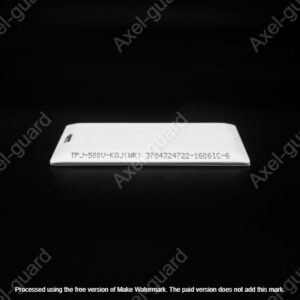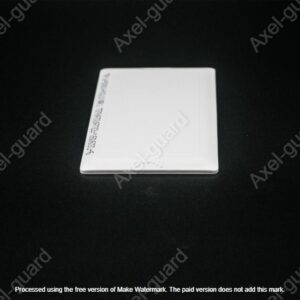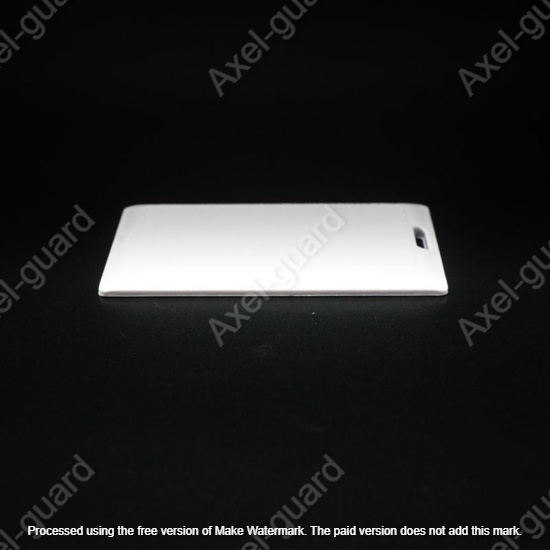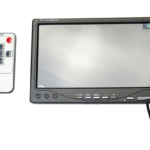Discover the benefits of Active RFID tags with Axel-Guard in real-time tracking and monitoring. Unlike passive RFID tags, Active RFID tags have their own power source, enabling long-range, reliable tracking for assets, security, and more. Learn how Axel-Guard can enhance your operations with this advanced technology.
In today’s fast-paced, data-driven world, efficient tracking and monitoring solutions are essential across numerous industries. From managing assets to enhancing security, the demand for real-time tracking solutions has made Active RFID Tags increasingly popular. Unlike passive RFID tags, active tags have their own power source, enabling them to transmit signals independently, allowing for broader applications and more reliable, long-range tracking.
This blog delves into the workings of Active RFID Tags, their advantages over passive RFID systems, and highlights the unique features of a popular option: the 2.4G Active RFID Tag (Card Type) HX607.
What is an Active RFID Tag?

An Active RFID Tag is a wireless device equipped with an internal power source, typically a battery, which allows it to continuously transmit data. Unlike passive RFID tags that rely on a nearby reader to energize them, active RFID tags can broadcast their signals over long distances. This feature makes them suitable for applications where real-time, high-frequency tracking is necessary.
Active RFID Tags are frequently used in logistics, healthcare, education, and corporate environments for tracking items, people, and even vehicles. With active RFID, data from multiple tags can be read simultaneously and over extended ranges, often up to 100 meters or more.
How Do Active RFID Tags Work?
Active RFID Tags operate by emitting radio signals, typically at intervals determined by the specific application. These signals are picked up by RFID readers, which then transmit the data to a centralized system for processing and analysis. This setup enables real-time tracking and the ability to monitor multiple tags across extensive areas.
Key components of an Active RFID Tag include:
- Battery: Provides power for transmitting signals.
- Microcontroller: Manages the data transmission intervals.
- Antenna: Transmits and receives signals.
- Memory: Stores essential information that the tag transmits.
Active vs. Passive RFID Tags: Key Differences
- Power Source: Active RFID Tags have a built-in battery, while passive RFID Tags rely on the reader’s power.
- Range: Active tags can transmit signals over longer distances (up to 100 meters or more) compared to passive tags (typically less than 10 meters).
- Applications: Active RFID Tags are ideal for tracking mobile assets, vehicles, and personnel, while passive tags are best for inventory tracking and identification in smaller, controlled spaces.
- Cost: Due to the additional components, active RFID tags are generally more expensive than passive tags but offer greater functionality and range.
Introducing the 2.4G Active RFID Tag (Card Type) HX607

The 2.4G Active Tag (Card Type) HX607 is an advanced active RFID solution designed for high-efficiency tracking applications. Manufactured for durability and ease of use, this RFID tag is ideal for environments that demand reliable tracking and long-range transmission.
Key Features of the 2.4G Active RFID Tag HX607
- Powerful Anti-Jamming Capabilities
Operating in a fixed frequency mode, the HX607 tag minimizes interference, ensuring accurate readings even in environments with multiple RFID tags and readers. This feature is essential for crowded or high-activity areas where jamming can impact other types of tags. - Extended Range
The HX607 tag boasts an impressive reading range of up to 80 meters, depending on the configuration of the reader and antenna. This extended range makes it a suitable choice for tracking across large spaces such as campuses, warehouses, and corporate buildings. - Multi-Tag Reading
The HX607 can read over 100 tags per second without interference. This capability allows for seamless tracking of numerous individuals or assets, making it an ideal solution for applications such as attendance monitoring, employee tracking, and vehicle tracking. - Low Power Consumption
Equipped with ultra-low power consumption technology, the HX607 has an average working current of less than 10uA. This design extends the battery life, allowing the tag to operate for up to three years, depending on usage. - Durability and Design
With an IP67 rating, the HX607 is water-resistant and heat-resistant, suitable for both indoor and outdoor environments. The ABS material makes it robust enough for rugged environments, and its compact, card-like design ensures it’s easy to carry or attach to various assets. - Flexible Working Bands
The HX607 operates on both 2.4GHz and 13.56MHz bands, offering flexibility in usage. The 13.56MHz range provides short-range data transfer for close proximity applications, while the 2.4GHz range enables extended tracking distances. - Data Storage and Compatibility
The HX607 has an 8Kbit memory that conforms to ISO14443A standards, allowing it to store necessary information for rapid transmission. This feature supports a range of applications that require data storage on the tag itself, like personnel tracking or secure access management.
Typical Applications of the HX607 Active RFID Tag
The 2.4G Active Tag HX607 is highly versatile, suitable for a wide range of applications:
- School Attendance Tracking: Track students’ attendance in real-time as they enter and exit school premises, ensuring safety and efficient record-keeping.
- Employee Monitoring: Monitor employees within large facilities, such as factories or warehouses, to ensure productivity and safety.
- Vehicle Tracking: The HX607 tag can be installed on vehicles to monitor their location, routes, and usage, helping reduce unauthorized use and improve fleet management.
- Asset Tracking in Warehouses: For large storage facilities, the tag can monitor high-value assets, enabling better inventory control and reducing losses.
How the 2.4G Active RFID Tag HX607 Improves Operational Efficiency
Implementing the HX607 tag can offer businesses substantial benefits:
- Enhanced Security: By using these tags, organizations can control access to sensitive areas and track individuals’ locations within a facility.
- Optimized Resource Management: With real-time tracking, companies can ensure resources are used efficiently and reallocate assets based on location data.
- Reduced Operational Costs: Tracking personnel and vehicles can significantly reduce costs associated with unauthorized usage, wasted resources, and misplacement of assets.
- Improved Compliance: For companies in regulated industries, active RFID tracking ensures that compliance standards are met, such as accurate attendance records and secure access.
Why Choose Active RFID Tags?
For businesses and institutions that prioritize security, operational efficiency, and real-time data, Active RFID Tags are indispensable tools. They offer longer ranges, real-time data tracking, and greater data storage capabilities than passive tags. Moreover, solutions like the 2.4G Active Tag HX607 present significant advancements in power efficiency and durability, making them a reliable choice for any organization.
Conclusion: Active RFID Tags as the Future of Tracking
Active RFID Tags, particularly the 2.4G Active RFID Tag (Card Type) HX607, provide a scalable, long-lasting solution for tracking and monitoring needs. From tracking school attendance to managing assets in large facilities, the HX607 stands out with its powerful features, durable design, and impressive range. With an increasing demand for high-efficiency tracking solutions, Active RFID Tags are set to transform industries across the board, enhancing productivity, security, and compliance.
If you’re looking to enhance your tracking capabilities, consider Active RFID Tags for a reliable, real-time solution that fits your needs. The future of tracking and asset management is here, and it’s active, connected, and efficient.
Frequently Asked Questions (FAQ)

Q1: What is an Active RFID Tag?
An Active RFID Tag is a type of RFID (Radio-Frequency Identification) tag that comes with its own power source, typically a battery. This built-in power allows the tag to transmit signals over a longer range, unlike passive RFID tags, which rely on power from a nearby reader. Active RFID Tags are ideal for real-time tracking of assets, vehicles, and personnel over large areas.
Q2: What are the main differences between Active and Passive RFID Tags?
The primary difference is that Active RFID Tags have their own battery and can actively broadcast signals over long distances, often up to 100 meters or more. Passive RFID Tags, on the other hand, don’t have a battery and rely on an RFID reader to energize them, limiting their range to only a few meters. Active RFID Tags are more suitable for tracking in larger, open areas, whereas passive tags are typically used for inventory and item identification in smaller spaces.
Q3: How does the 2.4G Active RFID Tag (Card Type) HX607 work?
The 2.4G Active RFID Tag HX607 is a powerful active RFID tag that uses a battery to transmit signals at set intervals. With features like anti-jamming capability, a reading range of up to 80 meters, and low power consumption, it is ideal for applications such as attendance tracking, vehicle monitoring, and employee tracking. It operates in both 2.4GHz and 13.56MHz bands, allowing flexibility in application and long-range tracking.
Q4: How long does the battery last in an Active RFID Tag?
Battery life varies depending on the tag model and how frequently it transmits signals. For instance, the 2.4G Active RFID Tag HX607 has an ultra-low power consumption design, which allows it to last up to three years under normal usage conditions. Battery life can depend on factors such as transmission intervals and environmental conditions.
Q5: Can Active RFID Tags be used outdoors?
Yes, many Active RFID Tags are designed for outdoor use. For example, the 2.4G Active RFID Tag HX607 has an IP67 rating, which means it is water-resistant and durable enough to withstand various outdoor conditions. It can operate in temperatures ranging from -20°C to +45°C, making it suitable for both indoor and outdoor applications.
Q6: What are common applications for Active RFID Tags?
Active RFID Tags are used across numerous industries for applications that require real-time, long-range tracking. Common applications include:
- Asset Tracking in large warehouses or industrial sites.
- School Attendance for monitoring students as they enter and leave premises.
- Employee Tracking within large facilities or construction sites.
- Vehicle Tracking to monitor vehicle location and usage.
- Inventory Management for high-value assets that require precise, real-time tracking.
Q7: How do Active RFID Tags improve operational efficiency?
Active RFID Tags allow for real-time tracking, which can improve resource allocation, enhance security, and reduce losses. They enable organizations to quickly locate assets or personnel, prevent unauthorized use of equipment, and improve compliance with safety standards. For example, the 2.4G Active Tag HX607 provides reliable, long-range tracking, helping businesses reduce downtime, monitor movements, and increase overall productivity.
Q9: Is the 2.4G Active RFID Tag HX607 compatible with existing RFID systems?
Yes, the HX607 is designed to be compatible with a range of RFID readers, and it supports ISO14443A protocol standards, which makes it easy to integrate into existing systems. It’s suitable for applications requiring hybrid band use, supporting both 2.4GHz and 13.56MHz frequency ranges, adding to its flexibility in diverse setups.
Stay Connected with Axel-Guard
We’re here to help you understand and implement the best tracking solutions for your business. Stay updated with the latest in Active RFID Tags and other innovations in tracking technology by following us on social media!
Follow Us on Social Media:
- Facebook: Axel-Guard on Facebook
- Twitter: Axel-Guard on Twitter
- LinkedIn: Axel-Guard on LinkedIn


